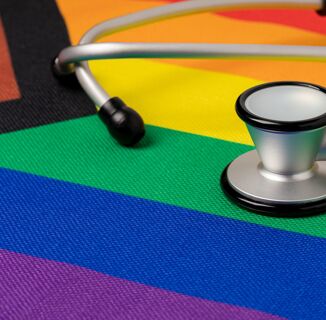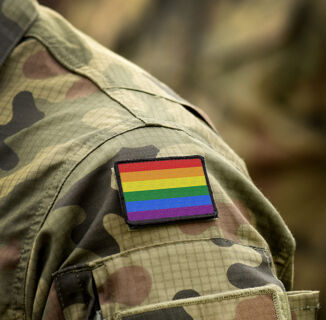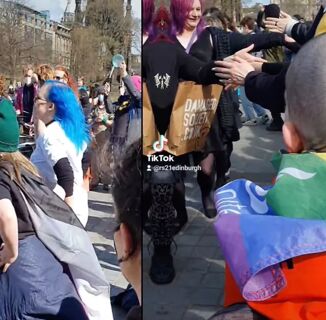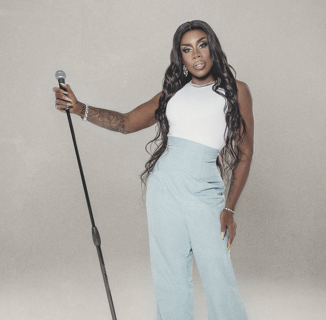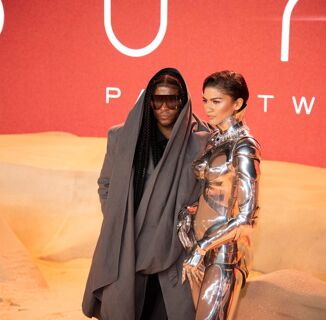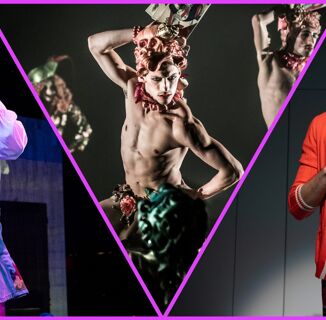This year’s Pride Parade in Provo, Utah was derailed by an act of God. Weeks before the modest parade was set to depart from Pioneer Park, a pair of lightning bolts struck the wilderness south of the Mormon stronghold, whose religious devotion is marked with a white letter “Y” carved into the hillside. Signifying the middle initial in Brigham Young University, the concrete apparition is draped in festive Christmas lights during the holiday season.
The fires that tore through Uinta National Forest and Bald Mountain continued to spread throughout the early days of September. It reached a tipping point by Sept. 13 — with the town’s 100,000 residents warned to avoid going outside.
While nearly 50,000 people turned out to the Salt Lake City Pride parade just months earlier, Pioneer Park was empty two days later — save for the smattering of vendors gathered for the weekly farmer’s market. The march wasn’t exactly cancelled. Given the martian brume of smoke which gave the cityscape an otherworldly quality hours before, its dissolution was understood.
But even the viscous air didn’t stop residents from turning out for the annual Pride festival, where attendees gathered with protective masks on. Once tucked away in a tiny park, the event was moved to the town center a few years ago. In a city where being out is an act of daily courage, dozens of vendors gather every year to show support for the LGBTQ community — from advocacy organizations like Human Rights Campaign and the Utah Pride Center to a local African restaurant selling curry chicken.
While Pridegoers gathered on the lawn to witness a lineup of performers ranging from drag queens to an all-LGBTQ cheerleading troupe, a small coterie of smiling figures stood along Center St. wearing “No Sides, Only Love” t-shirts.
That slogan is the motto of Encircle LGBTQ+ Family and Youth Resource Center, which opened in downtown Provo in February 2017; a second location is planned for Salt Lake City. The two-story house, which was built in the 1860s and sits on the National Register of Historic Places, is directly across from the Mormon Temple in Provo, Utah. If you look out the center’s front window, you can see the Mormon house of worship’s single white spire, topped with a golden statue of the angel Moroni playing a trumpet.
The proximity is no accident, according to Encircle Co-Founder Stephenie Larsen.
In 2016, a record number of LGBTQ youth took their own lives. Mama Dragons, a support group of affirming Mormon mothers of queer and trans kids, estimates that over 30 young people took their lives over a three-month span. Larsen, a children’s rights attorney, wanted to open a center “for kids who didn’t feel like their home was a safe place.” Her husband’s uncle, the late Salt Lake restaurateur John Williams, donated $100,000 to start that dream. Williams, who was openly gay, wanted the center to be in a strip mall, but Larsen knew that it had to be visible as possible.
“John wanted the house to be in a neighborhood where the kids could deal with their issues in private, but Provo needs to move forward,” Larsen told INTO. “If you can get your family behind you but you still don’t feel safe in your own community, then you need to leave.”
Unfortunately, many LGBTQ youth in Utah may lack the support of their relatives and loved ones. The state has among the suicide rates in the nation, as suicide is among the leading causes of death for children between the ages 12 of 17. A 2017 report from the Portland Press Herald claimed that 62 percent of queer and trans youth in the Beehive State attempt to take their own lives. There are few kids who haven’t lost someone close to them. Some have explained away this phenomenon as a result of the high altitude and low oxygen levels.
Other youth, who live in a state where an estimated 60 percent of the population is Mormon, cite a different phenomenon. Many young LGBTQ kids face being kicked out of their homes when they come out.
Zac Barker, a teenage student who lives in neighboring Orem, was accidentally outed to his mother after she discovered that he’d searched for instructional videos about “How to Come out to Your Parents” on YouTube. He forgot to delete it from his browser. Barker said that his churchgoing parents “accept [him] fully,” but school has been different. Although he describes his friends as “understanding and kind,” their parents stopped letting them hang out with him. Instead of being bullied or beaten up, Barker was frozen out.
“People don’t want to say anything rude, but they don’t want to be around you either,” Barker told INTO. “I felt alone. I felt like an outcast.”
The isolation that many LGBTQ youth in Utah experience can have devastating impacts. Jacob Dunford was a closeted, gay student at Brigham Young University before joining Encircle as the center’s program director. As a freshman at the conservative college, where homosexuality is still banned as part of its honor code, Dunford told INTO that his suffering was “invisible.” One morning, he put on his running shoes and ran to a secluded field up the street. It was pitch black. Dunford sat down in the middle of the grass and cried.
“I didn’t want anyone to see me crying because they would ask why,” he explained. “Now that we’ve started Encircle, people can run to the center. Now they don’t have to do it alone. It’s a beautiful thing.”
Dunford was instrumental in helping get Encircle off the ground. After transferring to Utah State University, he met Larsen. Although the center is largely operated through volunteer work, the two have worked tirelessly to raise funds for the center. Former NFL quarterback Steve Young, a former BYU student, gave $100,000. Tom Christofferson, whose brother is an LDS apostle, donated $25,000.
But most crucially, Holly Alden — CEO of the headphone manufacturer Skullcandy — offered to buy the property for Encircle and rent it back to them for $1 a month.
Larsen believes that support has been crucial to Encircle’s success. The center runs a packed house. On any given night, over 50 teens and adults attend the weekly events, which include storytelling nights and arts classes. There’s soup on the stove, cookies on the table, and someone ready to listen. One day a mother came to Encircle weeping because she thought her daughter might be a lesbian, and she didn’t know what to do. There was a volunteer waiting at the door with a shoulder to cry on.
“I’ve had youth tell me Encircle has saved their life,” Larsen said. “It gives them hope. It gives them friends. It gives them someone to talk to.”
But as Larsen knows, Utah’s LGBTQ youth need more than an ear to listen. Three years ago, the Church of Jesus Christ of Latter-day Saints enacted what’s now referred to in hushed tones as its “November policy.” Those guidelines stipulated that the children of same-sex couples would be ineligible to receive baptism rites. In order to be blessed by the church, they would have to renounce their parents’ marriage upon turning 18.
“To me, that really showed their true colors of how they feel about LGBTQ people,” Nathan Dalley, an 18-year-old who grew up in LeHigh, told INTO. “In the LDS Church, being gay or having a same-sex relationship is right up there with murder. It’s considered to be the same.”
Dalley, who left the church as a result of the November policy, lost a friend to suicide last year. Wyatt was one of two LGBTQ teenagers who took their own lives within in a single week. Dalley met him on Tinder and they stayed close, checking in with each other every few days. When one of them was having a hard time in school or dealing with their family, he would talk to the other about it.
“I could tell him basically anything,” Dalley said. “He understood what it was like to be gay in Utah. I didn’t have to explain it to him.”
But after a long day at work, Dalley couldn’t get in contact with his friend. This wasn’t like him. Dalley remembers Wyatt as having a “big heart,” the kind of person who took care of his friends before himself. If you were friends with Wyatt, you knew he loved you. Wyatt’s friends began to look for him and sent him frantic messages on Facebook, telling him that they were worried. Where was he?
That night, the boy’s parents posted on Facebook that he had passed away. Wyatt was just 17.
The state has worked in recent years to address this ongoing crisis. In 2017, Utah struck down its “No Promo Homo” law, which forbid teachers from addressing topics related to gender and sexuality in school. The Church of Jesus Christ of Latter-day Saints has publicly distanced itself from conversion therapy, the discredited practice of seeking to “change” the sexuality of LGBTQ youth. The Church relaunched its website on LGBTQ issues, Mormon and Gay, in an attempt to welcome queer and trans members into the fold. The banner on the current iteration states: “God Loveth His Children.”
But for every step forward the Mormon Church takes, it leaps right back. When 12-year-old Savannah came out to her Eagle Mountain congregation in May 2017, her mic was cut off. “There were scared of me and what I was saying,” she told the New York Times. The week of the Provo Pride festival, rainbow flags planted around the town were stolen; they were later returned.
While the Mormon Church struggles to accept its LGBTQ members, Encircle will be there waiting. The center operates 10 support groups, including groups for transgender folks, people recovering from addiction, and couples in mixed-orientation marriages — meaning one is gay and the other is straight. It offers low-cost therapy to kids who may be struggling with suicidal ideation. But more than anything, LGBTQ youth can come to Encircle and feel loved.
“Encircle is a place where you can come celebrate who you are,” Larsen said. “Hopefully that’ll add up in these kids lives.”
Help make sure LGBTQ+ stories are being told...
We can't rely on mainstream media to tell our stories. That's why we don't lock our articles behind a paywall. Will you support our mission with a contribution today?
Cancel anytime · Proudly LGBTQ+ owned and operated
Read More in Impact
The Latest on INTO
Subscribe to get a twice-weekly dose of queer news, updates, and insights from the INTO team.
in Your Inbox

